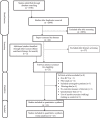Impact of exercise training on symptoms of depression, physical activity level and social participation in people living with HIV/AIDS: a systematic review and meta-analysis
- PMID: 35578192
- PMCID: PMC9109396
- DOI: 10.1186/s12879-022-07145-4
Impact of exercise training on symptoms of depression, physical activity level and social participation in people living with HIV/AIDS: a systematic review and meta-analysis
Abstract
Background: Symptoms of depression are prevalent in people living with human immune deficiency virus/acquired immune deficiency syndrome (PLWHA), and worsened by lack of physical activity/exercises, leading to restriction in social participation/functioning. This raises the question: what is the extent to which physical exercise training affected, symptoms of depression, physical activity level (PAL) and social participation in PLWHA compared to other forms of intervention, usual care, or no treatment controls?
Method: Eight databases were searched up to July 2020, according to the Preferred Reporting Items for Systematic Review and Meta-Analysis (PRISMA) protocol. Only randomised controlled trials involving adults who were either on HAART/HAART-naïve and reported in the English language, were included. Two independent reviewers determined the eligibility of the studies, extracted data, assessed their quality, and risk of bias using the Physiotherapy Evidence Database (PEDro) tool. Standardised mean difference (SMD) was used as summary statistics for the mean primary outcome (symptoms of depression) and secondary outcomes (PAL and social participation) since different measuring tools/units were used across the included studies. Summary estimates of effects were determined using a random-effects model (I2).
Results: Thirteen studies met the inclusion criteria with 779 participants (n = 596 participants at study completion) randomised into the study groups, comprising 378 males, 310 females and 91 participants with undisclosed gender, and with an age range of 18-86 years. Across the studies, aerobic or aerobic plus resistance exercises were performed 2-3 times/week, at 40-60 min/session, and for between 6-24 weeks, and the risk of bias vary from high to low. Comparing the intervention to control groups showed significant difference in the symptoms of depression (SMD = - 0.74, 95% confidence interval (CI) - 1.01, - 0.48, p ≤ 0.0002; I2 = 47%; 5 studies; 205 participants) unlike PAL (SMD = 0.98, 95% CI - 0.25, 2.17, p = 0.11; I2 = 82%; 2 studies; 62 participants) and social participation (SMD = 0.04, 95% CI - 0.65, 0.73, p = 0.91; I2 = 90%; 6 studies; 373 participants).
Conclusion: Physical exercise training could have an antidepressant-like effect in PLWHA but did not affect PAL and social participation. However, the high heterogeneity in the included studies, implies that adequately powered randomised controlled trials with clinical/methodological similarity are required in future studies.
Trail registration number: INPLASY202040048.
Keywords: Exercise training; HIV/AIDS; Mental health; Physical activity level; Social participation.
© 2022. The Author(s).
Conflict of interest statement
The authors declare that there is no conflict of interest.
Figures






References
Publication types
MeSH terms
LinkOut - more resources
Full Text Sources
Medical
Miscellaneous

